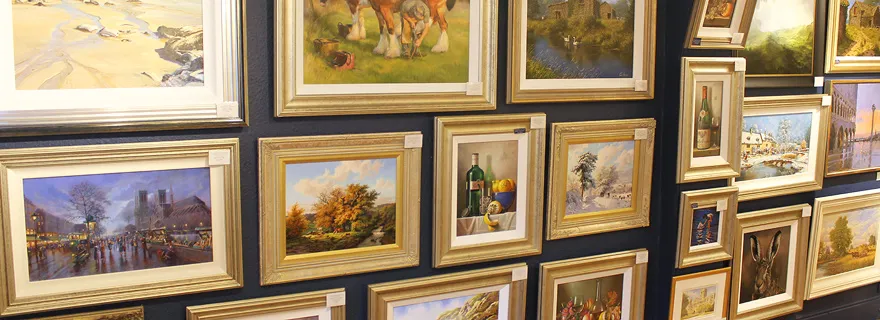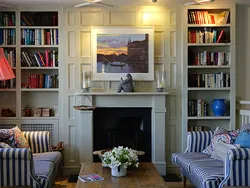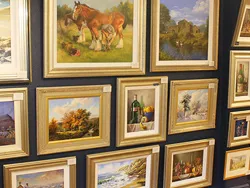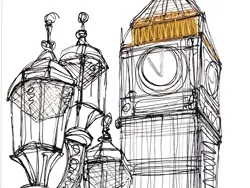
Collect Like A Curator: Tips for Building Your Fine Art Collection
There comes a time in every art collector’s life when he or she moves away from simply buying fine art to deliberately collecting it. While buying art can be a short term satisfaction, collecting art is a long term hobby that can bring a lifetime of pleasure. With a bit of forethought, collectors can take on the role of successful curator and build a collection that is greater than the sum of its parts.
Have A Strategy
What separates a good collection from a great collection is purpose. Don’t worry if you don’t have a defined purpose for your fine art collection from the start; when beginning a collection, it is perfectly natural to buy a few pieces for no other reason than the fact that you connect with them. But after those first few purchases, the best kinds of art collectors will be able to identify patterns and relationships between the individual pieces they have acquired, and use that information to create an acquisition strategy that enhances the collection as a whole.
When working to develop an acquisition strategy, it can help to think of your collection as an exhibition. How does your collection fit together? What question does it answer? The best curators are able to create exhibitions from seemingly eclectic pieces by basing them around a central theme, question or linear progression with a beginning, middle and end. Once you have determined the subject and significance of your collection, you can create an acquisition strategy that will help to guide future purchases and ultimately build a stronger, more meaningful collection.
Be Selective
Once you have developed a good acquisition strategy, it becomes infinitely easier to select which pieces to add to a collection. Using a gallery or collection’s acquisition strategy as a guide, curators selectively pick and choose significant pieces that will enhance a collection. A good curator knows not only why a piece is special in and of itself, but also why it is significant to the collection as a whole. The best collectors do the same, adding to a collection not only because he or she loves a piece, but also because it fills a gap in his or her collection.
It’s also important to be selective when considering the individual works of fine art themselves. For example, you may have decided that an oil painting by a particular artist will be a significant asset to your collection; but choosing the right piece is just as important as deciding to add a piece at all. Familiarise yourself with the artist’s work before buying, and buy pieces that are either unique or the best representation of an artist’s style.
Practice Good Documentation
As any curator knows, good documentation is absolutely paramount to the organisation and value of a collection. It is therefore important to keep a written record of your collection, regardless of its size. If you start documenting your collection early, you will save yourself the trouble of attempting to catalogue an entire collection at a later date. Things to include in your records include, at a minimum, the artist, medium, dimensions and title (if it has one); but the more information you can document, the better. Details such as purchase date and price, context of the artwork or the artist’s biography and professional accomplishments are all important pieces of information that can significantly enrich your collection.
As a supplement to your own written records, keep accompanying paperwork organised and safe. Provenance is incredibly important, particularly if there is a chance of future sales; so be sure to keep any original receipts and invoices. The more documented evidence you have the better. Certificates of authenticity, exhibition flyers or press clippings that relate to your artwork or their respective artists are also excellent supplements to your records.
Finally, make sure your documentation continues to evolve and stay current. Keep track of the artists whose work you have collected, and record any notable exhibitions, awards or acceptance to professional memberships or societies that develop. Similarly, keep an eye on the price of an artist’s work in order to maintain accurate and up to date valuations and insurance policies.
York Fine Arts offers valuation and full auditing and cataloguing services that may be of assistance to our clients. Contact the gallery for additional details.
Further News and Articles

Insight
We reflect on the myriad nature of figurative art and how to find the perfect fit for our homes and lifestyle.
[Full Article]
Press Release

Artists
A closer look at contemporary artist Angela Lyons and her positively mouthwatering paintings
[Full Article]
Insight
Curate the mood of your enviroment by making deliberate choices about the colour scheme of your fine art collection.
[Full Article]
Insight
How to build a significant collection that is greater than the sum of its parts.
[Full Article]
Artists
We excitedly welcome Edward Waite, the gallery's newest contemporary British artist.
[Full Article]
The Colomb Art Gallery, London is a fine art gallery to buy traditional fine art and contemporary fine art from British and internationally established artists. Buy art online ranging from original oil paintings to limited edition prints and sculpture. Gallery services include: Art Sourcing and Consultants, Painting Restoration, Art Exhibitions, Wedding List, Office Art, Gift Vouchers, Portrait Commissions.



